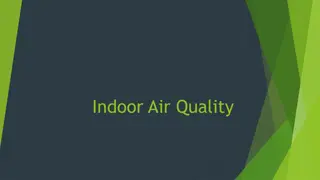Indoor Air Institute Workshop on SVOCs in the Indoor Environment
The Indoor Air Institute Workshop focused on Semi-Volatile Organic Compounds (SVOCs) such as plasticizers, flame retardants, and pesticides that are prevalent indoors, posing health concerns like endocrine disruption. The workshop aimed to understand the source-to-effect continuum, risk assessment approaches, and rapid exposure assessments for SVOCs. Key presentations included ToxCastTM, ExpoCastTM, dermal absorption measurements, PBPK modeling, organ-specific toxic effects, and environmental regulatory decision-making models.
Download Presentation

Please find below an Image/Link to download the presentation.
The content on the website is provided AS IS for your information and personal use only. It may not be sold, licensed, or shared on other websites without obtaining consent from the author.If you encounter any issues during the download, it is possible that the publisher has removed the file from their server.
You are allowed to download the files provided on this website for personal or commercial use, subject to the condition that they are used lawfully. All files are the property of their respective owners.
The content on the website is provided AS IS for your information and personal use only. It may not be sold, licensed, or shared on other websites without obtaining consent from the author.
E N D
Presentation Transcript
Indoor Air Institute Workshop: SVOCs in the Indoor Environment Brief Report by John Little Virginia Tech
Motivation for SVOC Workshop Semi-Volatile Organic Compounds (SVOCs) include: Plasticizers, flame retardants, pesticides, combustion products, anti-stain agents, heat transfer fluids SVOCs are ubiquitous indoors, redistributing from their original sources to indoor air, and subsequently to all interior surfaces including airborne particles, dust, and human skin Concern about exposure and health effects including endocrine disruption and asthma
Pilot SVOC Workshop at EPA Organizational Sponsor Indoor Air Institute Financial Sponsors EPA (NERL, HEASD Roy Fortmann; NCCT Robert Kavlock) and ACC LRI (Tina Bahadori) Date August 17 to 19, 2009 Co-Chairs John Little and Elaine Cohen Hubal Steering Committee Bill Fisk, Hal Levin, Tom McKone, Bill Nazaroff, Charlie Weschler Invited Participants Harvey Clewell, Miriam Diamond, John Kissel, Vickie Wilson
SVOC Workshop Questions 1. Can we characterize the source-to-effect continuum for one class of SVOCs (phthalates)? 2. Can the overall mechanistic risk assessment approach be generalized to other SVOCs? 3. Can we identify screening-level, rapid exposure assessment approaches?
Series of Presentations ToxCastTMand ExpoCastTMfor prioritization and chemical evaluation Elaine Hubal, EPA, National Center for Computational Toxicology Sources, emissions, transport, exposure and rapid screening for exposure John Little, Virginia Tech The mismeasure of dermal absorption John Kissel, University of Washington PBPK measurements, modeling, and metabolic reactions Harvey Clewell, The Hamner Institutes Organ-specific toxic effects of phthalates Vickie Wilson, EPA, Reproductive Toxicology Division Models in environmental regulatory decision making Tom McKone, UC Berkeley and LBNL
SVOC Workshop Questions 1. Can we characterize the source-to-effect continuum for one class of SVOCs (phthalates)? 2. Can the overall mechanistic risk assessment approach be generalized to other SVOCs? 3. Can we identify screening-level, rapid exposure assessment approaches?
SVOC Emissions model + particles yin= 0, TSP, Q . Ai y(t), TSP, Q q = Ksy . qp = KpyTSP V y(t) . Particles C0 = Ky0 h A x = L x C0 D x = 0 (Xu and Little, 2006 ) 7
Emissions of DEHP from vinyl flooring 1.8 3) DEHP gas phase concentration ( g/m 1.6 Chamber I Chamber II Model predicted 1.4 1.2 1.0 0.8 0.6 0.4 0.2 0.0 0 20 40 60 Time (days) 80 100 120 140 160 Xu et al., 2008
Make model more representative Make model more representative of real indoor environment of real indoor environment 9
Two-Room Model Ceiling Ceiling Particles Particles Wall Room 1 V1 y1 window Room 2 V2 y2 yin, TSP, Q Glass Glass window y2, TSP, Q y1, TSP, Q Wood furniture Vinyl Flooring Carpet 10
Partition coefficients for DEHP Surface Partition coefficient, Ks Furniture, wall and ceiling 2500 (m) Carpet Skin 1700 (m) 9500 (m) 0.25 (m3/ g) Airborne Particles 11
Residential Environment Compartment Volume (m3) Flow rate (m3/h) Main house 128 Qoa Qao Kitchen 35 Qok Qko Qak Qka Bathroom 15 Qob Qbo Qab Qba 65 44 12 32 44 24 1.1 2.1 14 13 Surface area (m2) Vinyl flooring Walls & Ceilings Carpet Wood floor Hard surface furniture 61.4 Windows & mirrors Tile & ceramic fixtures 5.12 TSP ( g/m3) 19.2 124 35.8 32.0 14.4 34.0 -- -- 12.6 1.75 3.50 20.0 6.20 23.3 -- -- 5.40 1.05 16.5 20.0 5.12 20.0 13
Residential Model Predictions 0.20 1.7 Bathroom Concentration Emission rate 0.15 1.6 Kitchen 2h) 3) Concentration ( g/m Emission rate ( g/m Main house 0.10 1.5 Main house 0.05 1.4 Kitchen Bathroom 1.3 0.00 0 100 200 Time (days) 300 400 500 14
Exposure for Child (2 to 3 yrs) 25 0.6 0.5 20 0.4 Exposure ( g/kg/day) Exposure ( g/kg/day) 15 0.3 0.2 10 0.1 Total Ingestion (Dust) Dermal Inhalation (Air+Particle) 5 6E-16 0 -0.1 0 100 200 300 400 500 Time (days) 15
Source to Effect Continuum Sources, emissions, transport, exposure and rapid screening for exposure John Little, Virginia Tech Dermal absorption John Kissel, University of Washington PBPK measurements, modeling, and metabolic reactions Harvey Clewell, The Hamner Institute Organ-specific toxic effects of phthalates Vickie Wilson, EPA, Reproductive Toxicology Division
SVOC Workshop Questions 1. Can we characterize the source-to-effect continuum for one class of SVOCs (phthalates)? 2. Can the overall mechanistic risk assessment approach be generalized to other SVOCs? 3. Can we identify screening-level, rapid exposure assessment approaches?
Indoor SVOC Dynamics Weschler and Nazaroff, Atmos. Environ., 2008
Estimating physical properties with structure-activity relationships (SPARC) Weschler & Nazaroff, Atmos. Environ., 2008
Measured vs. estimated [SVOCs] on hands Weschler & Nazaroff, Atmos. Environ., 2008
Measured vs. estimated [SVOCs] in dust Nazaroff & Weschler, Healthy Buildings, 2009
SVOC Workshop Questions 1. Can we characterize the source-to-effect continuum for one class of SVOCs (phthalates)? 2. Can the overall mechanistic risk assessment approach be generalized to other SVOCs? 3. Can we identify screening-level, rapid exposure assessment approaches?
Zero-Order Exposure Screening Excretion to production ratio (EPR): Ratio of the rate of excretion from humans (urine) to the rate of manufacture provides rough exposure indicator Dietary supplements or pharmaceuticals: EPR ~ 1.0 Personal care products: EPR ~ 0.01 to 1 Pesticides: EPR ~ 0.0001-0.01 Additives in indoor products: EPRs ~ 0.1-100 ppm Some estimated EPRs: Triclosan ~ 8000 ppm Pentachlorophenol ~ 500 ppm DEHP ~ 20 ppm
First-Order Exposure Screening Exposure to additives (e.g., plasticizers and flame retardants): Steady state concentration y (and hence exposure) depends primarily on y0, A and h y0 may be roughly equal to vapor pressure
At Steady State Q~ ( 1 ) y0 Q~ = + = + p 1 Q K TSP y h A Q~normal(50,20) Kp~normal(0.25,0.05) TSP~normal(20,5) h is correlated with Q 50000 random trials 25
Variability in Predicted Steady- State Gas-Phase Concentration 3500 3000 2500 Counts 2000 1500 1000 500 0 0 0.05 0.1 0.15 0.2 0.25 y/y0 0.3 0.35 0.4 0.45 0.5 26
Rapid Exposure Screening Zero-Order Screening Excretion to production ratio (EPR) Triclosan ~ 8000 ppm Pentachlorophenol ~ 500 ppm DEHP ~ 20 ppm First-Order Screening Exposure to additives (e.g., plasticizers and flame retardants) ~ y0 + ( 1 ) Q ~ = = + p 1 Q Q K TSP y h A
SVOC Workshop Outcomes 1. Can we characterize the source-to-effect continuum for phthalates? ~Yes 2. Can the overall mechanistic approach be generalized to other SVOCs? ~Yes 3. Can we identify screening-level, rapid exposure assessment approaches (and combine with info from ToxCastTM to estimate risk)? ~Yes 4. Summary paper being prepared for publication 5. SVOC Workshop 2 planned for end of 2010 or early 2011























